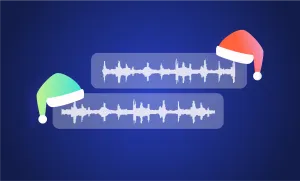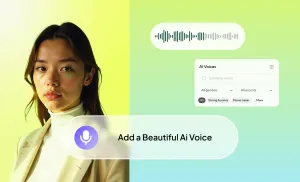Have you ever wanted to sound like someone else? Maybe you've seen a movie and been amazed by possible vocal transformations. But did you know it's possible to change your voice in real life too? While it may not be as impressive as what you see on the big screen, but it can still be fun and useful for various purposes.
In this article we'll discuss how and why you might want to change the sound of your voice.
Voice Cloning: Myth or Reality?
We’ve come a long way from early voice-changing devices like the vocoder used to create the iconic robotic sound in songs like Daft Punk's "Harder, Better, Faster, Stronger". Nowadays, voice cloning technology has progressed to the point where it's becoming more and more realistic with every iteration.
Most recently, there have been even more advancements in the voice cloning field. The first iteration of the technology could only create a few seconds of realistic-sounding speech, whereas the newest AI-powered software can generate extended and continuous natural speech. It’s no secret anymore: the era of voice cloning is upon us, and it will only get better from here.
How Does Voice Cloning Work?
Voice cloning creates a digital model of someone’s vocal tract based on recordings of their voice. It studies their unique characteristics, like pitch, tone, cadence, and other vocal nuances, and using this data, the system can then build an AI model that replicates that person's voice.
That way, when you feed the model new text, it can generate synthetic speech that sounds just like the original speaker. The end result is a digital version of that person's voice that can be used to create new audio – a digital clone!
How to Change Your Voice to Sound Like Someone Else
Every human is unique, and our voices have much to do with that. The shape of our vocal tract, the size of our larynx, and the way we use our muscles all contribute to the sounds we make when we speak.
But as we know it, the methods of how to change your voice can be divided into three categories: manual (or physiological), hardware-based, and software-based. Let's find out how each of them works.
Manual or Physiological Methods
To change the sound of your voice naturally, you need to learn how to control the muscles in your vocal tract. They include the larynx, vocal cords, and lips. You’ll also need to know how to control your diaphragm.
These exercises might require a lot of practice, but here are a few methods professional voice actors and vocal coaches use:
- – Strengthen Your Neck: Focus on exercises that target the two long muscles that run from behind your ear to your collarbone. These help you gain better control over your vocal chords and achieve a deeper, richer tone.
– Diaphragm Breathing: This technique not only helps deepen your voice and ditch shallow breathing, but also improves vocal resonance and overall breathing efficiency.
– Practice Aspiration: Experiment with a breathier, more aspirated vocal delivery. This subtle adjustment can immediately lower your pitch while also lending an attractive, velvety quality to your voice.
– Stay Hydrated: Dehydration leads to a higher-pitched, thinner-sounding voice. Make a conscious effort to drink plenty of water throughout the day to maintain optimal vocal health and depth.
– Be Monotone: Reducing pitch variation can actually enhance the perceived depth of your voice. Aim for a more even, steady cadence when speaking.
These are all great techniques to change your voice naturally, but how do you go about changing your voice in more drastic ways?
Hardware-Based Methods
If you want to change your voice in real time, you will need a hardware device. The most common devices are voice changers and microphones that process your voice and change it with sound effects. For example:
- – Vocoders: Vocoders are electronic devices that can modify the timbre and pitch of a voice. They work by separating the harmonic and noise components of the voice and then recombining them in new ways. This can create robotic, synthesized, or otherworldly voice effects.
– Autotune Microphones: These are microphones that have built-in autotune functionality. They can automatically correct the pitch of the recorded voice in real-time, creating the distinctive "auto tune" vocal effect.
– Pitch Shifters: Standalone hardware pitch shifters can raise or lower the pitch of a voice without affecting the tempo. This allows for creating deeper or higher-pitched voices.
– Harmonizers: Harmonizer effects units can add additional vocal harmonies to the original voice, creating a layered, multi-voice sound.
Voice changers come in many shapes and sizes, from simple plug-and-play devices to more sophisticated units requiring a certain amount of tweaking to get the perfect sound. But these can be costly, and sometimes the simplest methods are the most effective. Which is why it’s worth investing in software for the best results.
Software-Based Methods
Changing your voice for a more dramatic transformation or for longer periods requires specialized tools and platforms. Today, the market is flooded with all sorts of software that claims to be able to change your voice.
There are two ways to go: by using voice-altering software, or by using text-to-speech software. The most popular and effective voice-changing software uses artificial intelligence (AI) that learns how to mimic your voice. All you need to do is record yourself speaking for a few minutes, and the software will do the rest.
In fact, the secret weapon we have for you is an AI-powered solution. Let's quickly take a look.
Use AI to Create a Digital Copy of Your Own Voice
Minutes! That's how long it takes to get started with Podcastle. Initially created as a podcast recording software, Podcastle is constantly evolving to meet the needs of its devoted users.
One of the most recent additions to the software is the brand-new voice cloning module! Based on deep voice learning and artificial intelligence, the module can create a perfect copy of your voice.
While most other tools require recording yourself for hours, with Podcastle you can clone your voice in seconds by recording a short sample directly on the platform—no microphone or extra software needed. The technology will analyze the recording, learn the speaker's intonation, accent, and other nuances, and create a new voice model. Then, you can use this model to generate as much speech as you want.
Converting Text-to-Speech: How-to Guide
If you instead want to use text-to-speech (TTS) to turn a written message into speech, Podcastle has you covered. The tool has a built-in AI Voice Generator that can read any text and recite it in your voice or in one of a selection of pre-existing voices.
To change your text into speech, simply type or paste the text into the text box and click on the 'Generate' button. The software will start reading the text aloud in one of 30+ voice skins or your newly created voice.
Pro hint: Podcastle has gone even further with its voice-to-text converter. You don't need to type the text this time – the software will do it for you! Just record the speech, and Podcastle will transcribe the recording and convert it into text.
Podcastle is also perfect for those who are not comfortable with recording themselves. The software can generate speech from the text you provide without you having to say a word!
Use AI to Create Voice Skins for Content Creation
If you're going the software route, you can even take it a step further and experiment with different voice skins. Podcastle has over 30+ voice skins you can choose from, each with unique timbres, accents, and personalities. For content creators, these voice skins could allow them to narrate in different styles, bring characters to life, and even simulate interviews or conversations.
Here’s a rundown on some of the benefits from using voice skins for content creation.
1) Choose Your Voice
AI voice skins provide content creators with a wide range of options to choose from, allowing them to select the perfect tone and style to suit their content or branding. If you need a professional narrator for a documentary, a lively host for a podcast, or a character voice for an animated video, these skins offer endless possibilities to cater to diverse audiences.
2) Save Time
Recording voice overs or narrations can be a time-consuming process, especially for lengthy projects. AI voice skins offer a time-saving solution by generating high-quality recordings in a matter of minutes. As a content creator, you can significantly reduce production time and meet tight deadlines without sacrificing quality, allowing them to focus on other aspects of their projects.
3) Be Consistent
Sometimes the greatest challenge might just be maintaining a reliable, predictable quality or style. But with voice skins, you have a reliable speaker at your disposal that aligns with the creator's brand and style. Whether it’s about producing a series of videos or launching a new podcast episode, content creators can rely on these skins to deliver consistent and professional-quality audio every time.
4) Experiment
AI voice skins are all about promoting creativity and innovation. You can explore new storytelling techniques, experiment with character voices, or even create unique personas for your content. This freedom to explore and innovate fuels creativity and allows you to push boundaries in your everyday content creation tasks.
Fun Scenarios to Use AI Voice Skins
With AI, there’s a time for work and a time for play, because you can also create amazing voice skins for fun, creative and practical applications. The options are simply endless. For instance, you can use voice skins for:
- – Online Gaming Experience: Inject personality and variety into your online adventures. Each player could have a unique voice that adds a whole new level of excitement to your gameplay.
– Virtual Assistant Interactions: Transform mundane tasks into fun interactions by customizing your virtual assistant's voice however you wish. You can at last say bye to all the generic robotic tones and hello to a virtual assistant that speaks your language.
– Audiobooks: Ever thought of becoming the next big audiobook narrator but don't quite have the guts for it? Well, now you’ve got your very own professional narrator without ever needing to step foot in a recording studio.
– Fun, Silly Pranks: There’s always room for harmless pranks, like sending voice messages or calling your friends while impersonating a celebrity, famous character, or just generally trying to make your voice sound funny!
FAQ
How accurate is voice cloning technology today?
It has advanced significantly in recent years, with AI-powered software capable of generating highly realistic speech that closely mimics the original speaker's voice. While it may sound like it’s coming from a human in all cases, the technology continues to improve, making it increasingly difficult to distinguish AI from authentic speech.
What are the benefits of voice cloning?
Changing your voice can have several benefits, including enhancing creativity in content creation, adding entertainment value, improving accessibility for those with speech disabilities, and providing anonymity in online interactions. These alterations can be used for practical purposes as well, such as language learning, dubbing, and voiceovers. For instance, dubbing software allows creators to replace the original audio with a new track in another language, making content accessible to a global audience. It's a vital tool in multimedia localization, allowing for seamless integration of voiceovers that match the original performance's timing and emotional tone.
How does Podcastle create a digital copy of my voice?
Podcastle uses deep voice learning and AI to analyze recorded speech samples and create a personalized model. Users only need to provide a short recording of themselves speaking, and the technology learns their intonation, accent, and other nuances to generate a digital copy of their voice.
What are some practical applications of AI voice skins for content creators?
They can be used by content creators to streamline their workflow, save time on recording and narration, maintain consistency across projects, enhance accessibility for diverse audiences, and unleash creativity by experimenting with different voices and styles.
I hate recording myself. Can I use Podcastle's text-to-speech feature instead?
Of course! Our TTS feature is ideal for those who may not feel comfortable recording themselves or who prefer not to use their own voice for narration. The software can generate speech from written text, allowing users to create audio content without the need for voice recording.








